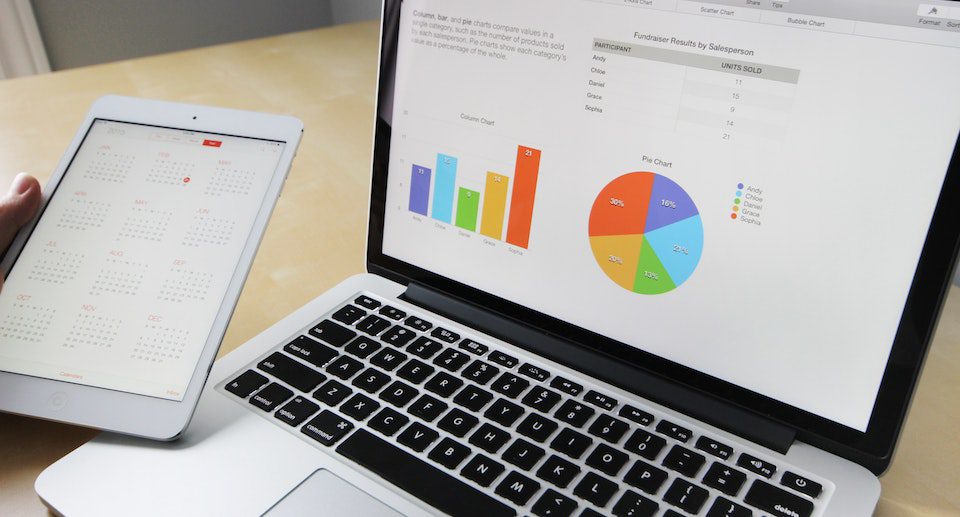
Pay-per-click (PPC) ads are a powerful marketing tool for bringing highly qualified traffic to your website. They target consumers who are actively searching for a product or service. But as with any other marketing effort, PPC ads require monitoring, analysis, and optimization to yield remarkable results.
In this PPC guide, we’re discussing 11 key metrics that you should keep your eye on in order to improve your campaigns and make the most of your advertising budget. We’ll also share some PPC tips along the way so let’s jump in!
Table of Contents
1. Impressions
Impressions are the number of times your ad shows up on someone’s screen. There’s no need for any action from the user’s side, simply seeing the ad is enough to count as an impression. You can track your ad’s impressions on your analytics dashboard.
Even though this metric is not as important as the others mentioned in this PPC guide, it’s still needed for measuring the visibility of your ad. For instance, if your impressions are low, it indicates that your ad is not being seen by your intended audience. This could be due to a number of reasons such as your target audience being too small or your keywords being too niche-specific which leads to low search volume.
2. Cost per Mille (CPM)
Next on our PPC metrics guide is the cost per mille. Also known as cost per thousand impressions, CPM tells you how much it costs to show your ad 1,000 times. It’s a helpful metric for evaluating your ad’s performance and making predictions on how much budget you’ll need to increase your visibility for marketing on a larger scale.
CPM data can be found on your dashboard as well but here’s a simple formula for calculating it:
CPM = (Total Cost / Total Impressions) x 1,000
For example, if you’ve spent $100 on your campaign and have received 3000 impressions, your CPM would be (100/3000)*1000 = $33.33.
Impression share is a measure of the percentage of impressions on your ads. It tells you how many impressions your ads are getting compared to what they’re eligible to receive. This metric is essential for analyzing how successful your ads are at competing for attention with your competitors and figuring out the gaps you can fill to maximize your performance. You can also find information on impression share loss due to budget and ad ranking on your dashboard. We won’t be covering these in this PPC guide but you can use Google’s documentation for tips on these PPC metrics.
Here’s the formula to calculate your impression share:
Impression share = (Total Impressions/Impressions Eligible)*100
For example, if the keyword you’re targeting was searched 200 times but your ad showed up for only 50 of those searches, then your impression share is 25%.
4. Quality Score
If you’re running search ads on Google, another thing to keep track of is the quality score. Google’s algorithm takes your bid amount, landing page quality, keyword relevancy, and some of the metrics like CTR mentioned in this PPC metrics guide, into account to determine where to position your ad in comparison to your competitors.
If your quality score is high, it means your ads will be shown to users before your competitor’s ads. It could also mean that Google charges you less per click on a term than other competitors with a lower quality score. You can view your quality score on your dashboard. Using other types of PPC ads where quality score isn’t available? Our PPC tip is to keep track of metrics for landing page experience and ad relevance.
5. Clicks

When a person interacts with your ad by clicking on the image, the link, or any other part of the ad, it’s counted as a click. Keeping track of clicks is necessary to guide your PPC efforts in the right direction because it will help you determine whether your ad is hitting the mark with your intended audience or not. For instance, if your ad is receiving good impressions but low clicks, it could mean that you need to follow best practices and PPC tips for better targeting, ad creativity, or messaging.
To see the number of clicks your ad has received, you’ll have to go to your analytics dashboard and view the data under your ‘Goals’ by selecting the right ad or campaign.
6. Cost per Click (CPC)
Number six in our PPC metrics guide is Cost per Click (CPC) which tells you how much you’re paying each time someone clicks on your ad. This metric changes depending on the competitiveness of the keywords you’re targeting. For example, if you’re targeting keywords with a high search volume, you’ll likely see higher CPCs than standard because you’re trying to outbid your competitors.
Here’s the formula for calculating your cost per click:
CPC = Total Cost/Total Clicks
By keeping an eye on your overall CPC you can set an appropriate budget to achieve your desired results and find out when you need to switch up your ads.
PPC tip: If you want to compete for a high search volume keyword, then you can also manually increase your bid amount to increase your ad’s visibility. Learn how to do this using Google’s guide for PPC bidding.
7. Click-Through Rate (CTR)
Click-through rate (CTR) is the measure of the percentage of clicks you received compared to the number of times your ad was seen. Measuring your CTR gives you a deeper insight into the performance of your ads and how relevant and engaging they are. A low CTR means that you’re either targeting the wrong audience or your ads are simply not enticing enough to grab your audience’s attention.
Here’s how to measure your CTR:
CTR = (Total Clicks/Total Impressions)*100
If you have a low CTR, ensure you’re targeting the right keywords and start A/B testing your messaging and call-to-action (CTA). This PPC guide for A/B testing has some helpful tips for PPC CTR success.
8. Conversions
Conversions are the end goal you set for your PPC campaign. Every time a user clicks on your ad and performs your desired action, it’s counted as a conversion. That action could be signing up for a newsletter, taking a quiz, booking a call, adding something to their cart, or purchasing a product. You’ll see your conversion data in your analytics dashboard under results if you’ve set your desired goal as the conversion metric.
Unless you’re tracking this metric from our PPC guide, there’s no way for you to know whether your ads are performing or not and whether you’re even achieving the goals you set out before starting the campaign. You could be getting lots of traffic and engagement with hardly any conversions. In fact, only 2.3% of visits to e-commerce websites result in a conversion. It’s only by keeping track of this metric that you can figure out how to fine-tune your keywords, messaging, and CTAs.
9. Cost per Conversion
Cost per conversion (not to be confused with cost per click (CPC) covered earlier in our PPC guide) tells you how much you’re paying each time a conversion takes place through your ad. This is an important metric for assessing how cost-effective your ads are and whether the cost accrued to acquire a customer is in alignment with long-term profitability. Emphasis on “long-term” because you need to account for customer lifetime value (CLV) to evaluate whether a higher cost per conversion is worth paying for.
For example, if you’re selling a $35 pack of coffee and it costs you $20 to acquire a customer, then the cost would be worth it if that customer becomes a regular and purchases from you every month. Read this PPC budget guide for more on budgeting for your campaign.
Here’s how to measure cost per conversion:
Cost Per Conversion = Total Cost/Total Conversions
While you’re tracking your CPC (cost per click), our PPC tip is to also track your cost per lead (CPL), i.e., how much you’re spending to attract a lead. This will help you assess and thereby reduce the cost of converting that lead into a customer.
10. Conversion Rate
Conversion rate is one of the most important metrics in our PPC guide. It’s a measure of the percentage of conversions that take place to the number of conversion attempts that were made. Here, the latter refers to the number of clicks. Measuring your conversion rate gives you a wider view of the conversions that are taking or not taking place in real, tangible digits.
Here’s the formula for calculating your conversion rate:
Conversion rate = (Total Conversions / Total Clicks)*100
Use this formula from this PPC guide to find your conversion rate and gain a deeper understanding of your audience’s search intent and readiness to make a purchase. You’ll be able to see just how many opportunities you’re missing and how to turn the tides in your favor so you can drive maximum results.
11. Return on Ad Spend (ROAS)

Return on ad spend (ROAS) tells you how much revenue you’ve generated compared to the amount you invested in your ads. If you’re spending $1000 on your ads and are generating $1200, your total profit is $200, which might not be much of a profit if you also take into account your total return on investment (ROI) which includes additional expenses such as agency fees, product manufacturing costs, logistics and shipping, etc. This is why it’s essential to measure your ROAS so you know when you need to guide your PPC strategy in a different direction.
Here’s the formula for calculating your return on ad spend:
ROAS = (Total Ad Revenue/Total Ad Cost)*100
What’s considered a good ROAS? As with your CPC, determining whether your ROAS is good or bad will depend on how much you’re okay with getting in return through your ads in order to acquire new customers. If you’re sure your new customers will come back to buy more products, then simply breaking even with your ROAS might be enough.
Data-Driven PPC Campaigns for Success
With 8.5 billion searches per day, paid advertising can be a game-changer for your business and with our PPC guide, you’re now equipped with the knowledge to decode your data and make decisions based on solid numbers. If your metrics are telling you that you need to readjust your strategy ASAP but you’re not sure what changes to make to drive better results, feel free to contact the experts at Coalition Technologies for guidance.
We’ve helped thousands of our clients generate millions in revenue through data-driven PPC marketing strategies and PPC tips and guides, so we’d be happy to review your efforts and offer our input. Contact us today to get a free strategy review!


